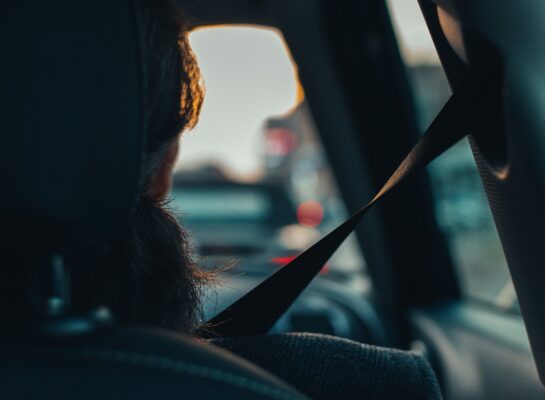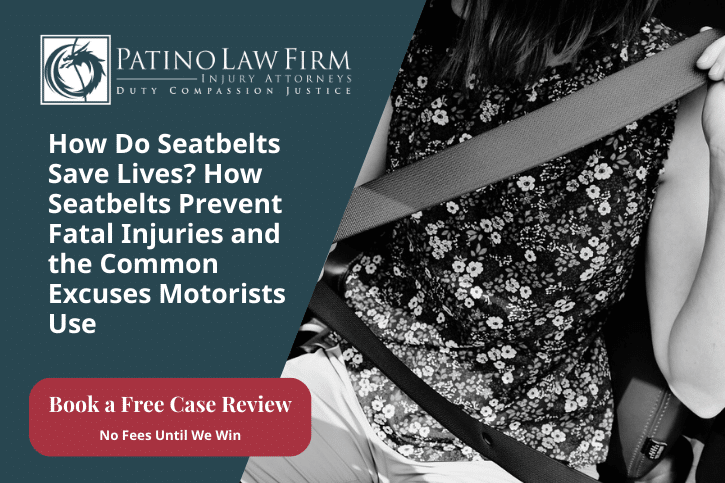Seatbelts — every car has them, but a shocking number of motorists and passengers forgo this vital life-saving measure. Learn why as we show how seatbelts save lives and debunk common excuses.
According to the National Highway Traffic Safety Administration (NHTSA), 50% of the 26,325 passengers killed in U.S. car accidents in 2023 were not wearing a seatbelt. It’s a shocking statistic with a clear message: seatbelts save lives.
What Else Do the Statistics Say about How Seatbelts Save Lives?
NHTSA statistics show that a record-breaking 91.9% of motorists and passengers wear seatbelts, an over 10% increase compared to 2004. But that also means just under 9% — totaling millions of Americans across the nation — fail to buckle up.
But it’s not just the life-saving benefit that makes wearing a seatbelt worthwhile. Additional statistics show that seatbelt use is vital for reducing your risk of any injury:
- Seatbelts reduce the risk of fatal injury by 45% and moderate and critical injuries by 50% for front-seat passengers and drivers.
- Seatbelts reduce the risk of fatalities by 60% and moderate and critical injuries by 65% for light truck occupants.
- Seatbelts saved an estimated 14,955 lives in 2017 and would have saved an estimated 2,549 more if motorists had buckled up.
- Between 1960 and 2012, seatbelts saved hundreds of thousands of lives — 329,715, specifically — making it the single most effective technology for saving lives in automotive history. This statistic shows that the humble seatbelt has saved more lives than any other safety feature combined, including airbags and electronic stability control. This figure is skewed by the fact that seatbelts have been used far longer than many of these other technologies, but their life-saving impact is still undeniable.
Seatbelt use — or the lack thereof — also affects children’s safety. Research shows that 39% of children aged 14 and under killed in car accidents were not wearing seatbelts. The percentage increases to 58% when looking solely at teenagers aged 13 and 14. Child restraint use also drops by 40% when their parents do not buckle up.
The Life-Changing Impact of Not Wearing a Seatbelt
Car accident fatalities are far from isolated events. A loss is tragic enough, but each death has a ripple effect, impacting friends and immediate loved ones and robbing countless families of years — even decades — of treasured memories. This scenario becomes even more heartbreaking when we understand that so many deaths could have been prevented with the simple click of a seatbelt.
The Dangers of Not Wearing a Seatbelt
When a motorist or passenger who fails to buckle up survives a car accident, they often sustain severe, even life-threatening injuries.
Car accident victims frequently sustain fractures, bruising, internal injuries, spinal cord injuries, and traumatic brain injuries, but these injuries are often far worse for those who do not secure their seatbelt.
During a crash, everything inside a vehicle continues its trajectory at the speed the vehicle was traveling before impact, and if you’re not wearing a belt, that includes you. By securing you in place, a seatbelt prevents you from being thrown into other passengers or around your car during a rollover accident.
One of the most significant dangers of not wearing a seatbelt is the risk of being ejected from your car during impact. Passengers who don’t buckle up are thirty times more likely to be ejected during a crash, which can prove fatal.
Not wearing a seatbelt also has significant financial implications. With more severe injuries often comes the need for more extensive, long-term treatment, leading to larger medical bills.
How Seatbelts Save Lives
Seatbelts are essential for keeping you and others safe while driving, but how do they save lives, and is there a wrong way to wear a seatbelt?
Seatbelts Provide Protection during a Crash
Wearing a seatbelt protects you during a crash by absorbing the momentum and spreading the impact across your chest, hips, and shoulders — which are more able to withstand sudden force — significantly reducing injury severity.
For example, if you sustain a whiplash injury caused by the rapid back-and-forth movement of the head and neck, wearing a seatbelt can make the difference between experiencing a sore and stiff neck and sustaining a traumatic brain injury that leaves you with memory loss, persistent headaches, trouble concentrating, or even struggling to communicate.
How to Wear a Seatbelt the Right Way
We’ve all experienced running late and being in a rush to get to where we need to go, and you might have hastily clicked your seatbelt in place without considering if you were wearing it correctly.
The proper usage of a seatbelt is critical to provide maximum protection. You should secure the lap belt across your pelvis — not your stomach — and the shoulder belt across your rib cage.
Adjust your belt as needed so you’re snug in the seat without feeling discomfort.
Ensuring your seatbelt and those of your passengers are secured correctly takes just a few moments, and it could save a life.
A Universal Safety Measure
Whether you drive a car, an SUV, or a truck, seatbelts save lives. You may be an experienced driver who has never even received a ticket, but that doesn’t make you immune from an accident. We can’t control the actions of other motorists on the road, and an accident can happen at any time. But you can consciously decide to minimize the risk for yourself and your passengers, making a potentially devastating situation a little bit safer.

The Consequences of Not Wearing a Seatbelt
The main danger of not wearing a seatbelt need not be repeated, but the consequences go beyond the obvious, and there are several other repercussions of failing to buckle up.
Potential Legal Ramifications
If you’ve ever needed to drive around the block or been in a hurry, you might have neglected to fasten your seatbelt. What you might not realize is it’s a criminal misdemeanor. Drivers caught not wearing a seatbelt face fines and court costs of up to $200, as outlined in Section 545.413 of the Texas Transportation Code. The maximum fine increases to $250 for drivers caught transporting children up to eight years old without securing them in a child safety or booster seat — unless the child is taller than four feet, nine inches, in which case they must be secured by a traditional seatbelt.
It used to be that Texas law only required front-passenger drivers to wear seatbelts, but awareness of the dangers of not wearing a seatbelt and overall attitudes toward driver safety have come a long way since then. If you’re driving a vehicle in Texas, you’re responsible for the safety of all your passengers — and will be penalized accordingly if they fail to buckle up.
Receiving a citation is also likely to impact your insurance premiums. Auto insurance carriers won’t look favorably on an infraction and might perceive you as a risky driver.
Emotional Distress after an Accident
Any car accident can cause emotional distress. It’s a traumatic event, and it’s common for drivers to experience significant anxiety or post-traumatic stress disorder after a crash. Some survivors struggle to even talk about their accident, let alone get back behind the wheel.
One of the common — albeit lesser spoken about — psychological impacts of an accident is survivor’s guilt, which happens when a person involved in a car accident survives or sustains minor injuries while another tragically dies or suffers severe or life-changing injuries. Survivors can grapple with intense guilt, and it can be debilitating. Experiencing survivor’s guilt after an accident that causes catastrophic or fatal injuries to a stranger is challenging enough, but it’s especially devastating when seatbelt safety is involved.
A driver might feel tremendous guilt if they didn’t buckle up and their loved one was hurt in a crash despite wearing a seatbelt. Likewise, a driver might feel responsible for the injuries of a passenger not wearing a seatbelt.
There is no way to know how differently an accident might have turned out, but wearing a seatbelt doesn’t negate the risk of injury. A driver might have sustained the same injuries even if they had buckled up. A motorist might wish they had insisted their passenger wear a seatbelt, but that doesn’t mean they would have listened or their injuries would have been any less severe.
We might know these things rationally, but survivor’s guilt works on a different level. It plagues accident survivors with “what-ifs” and “if-onlys”, and it can have a devastating effect on their quality of life.
Areas in Greater San Antonio We Serve
Debunking the Myths about Wearing a Seatbelt
Many people have misconceptions about wearing a seatbelt, questioning their necessity and effectiveness. Here, we address some of the common myths surrounding seatbelt safety that potentially endanger drivers and passengers.
“I don’t need a seatbelt for a short drive.”
It can be tempting to forgo a seatbelt if you’re only going to be in the car for a few minutes, but an accident can happen at any time.
“My airbag is enough to protect me.”
Airbags are not a replacement or alternative to seatbelts, and relying on an airbag alone can cause substantial harm. If you do not wear a seatbelt and are hit by another vehicle, inertia can throw you forward toward the airbag. The force of a rapidly deploying airbag can be fatal.
“I’m pregnant, so I shouldn’t wear a seatbelt.”
Pregnant women may worry that wearing a seatbelt could injure their unborn child if they’re in a crash, but the opposite is true. Wearing a belt is entirely safe if you secure it correctly: place the lap belt under the belly and the shoulder strap between the breasts, never under the arm.
Texas law clearly defines who is exempt from this safety requirement — certain professionals who must frequently exit and re-enter their vehicle have a valid defense if caught without a belt; otherwise, individuals must have a written statement from a licensed physician stating they should not wear a belt for a medical reason.
“Wearing a seatbelt can cause severe injuries — it must be safer to be thrown from my car.”
It’s a fallacy that it’s safer to be thrown from your vehicle than to suffer injuries from wearing a seatbelt or being struck by other objects in your car. Data from the NHTSA states that more than three out of four people ejected from their vehicle in a crash die from their injuries — and drivers and passengers are 30 times more susceptible to ejection when not wearing a seatbelt.
Seatbelts can cause minor bruising during a significant impact, but that’s a small price to pay compared to the injuries you would likely sustain if not wearing one.
“I can brace myself.”
Many drivers overestimate their ability to brace themselves for impact, but no amount of physical strength can counteract the force a collision can inflict. Crashes also often happen in the blink of an eye, so it’s unlikely you’d have time to prepare yourself even if it were physically possible.
“I am a good driver and don’t need a seatbelt.”
One of the most dangerous myths about seatbelt safety is that good drivers don’t need to wear seatbelts. Car accidents don’t discriminate. You could have a spotless driving record and never so much as had a scare on the road, but that can change at any time. A jaywalker can appear out of nowhere, leaving no time to react. You can be at a stoplight when a distracted driver reading a text crashes into the back of your car. You cannot control the actions of other motorists, and that’s where the danger lies. A good driver knows a seatbelt prepares them for the unexpected — nobody is immune to an accident, however skilled they are.
Get Compensation with the Help of Our Texas Car Accident Lawyer
If you’re injured in an accident caused by someone else’s negligence, you might be entitled to compensation for your injuries. While the main reason for wearing a seatbelt should always be to reduce the risk of sustaining severe injuries in a crash, a Supreme Court judgment provides another compelling reason to buckle up.
Legal precedent previously meant that a driver’s decision to not wear a seatbelt could not be used against them in a civil claim. Effectively, this meant if you were injured in an accident and you were not wearing a seatbelt, evidence of that fact was inadmissible in a lawsuit. However, in 2014, the Supreme Court of Texas overturned the ruling, making evidence of the non-use of a belt admissible for apportioning responsibility.
In simple terms, this means a defendant can argue that your failure to wear a seatbelt makes you partially responsible for your injuries, reducing their liability. Texas laws allow accident victims to recover compensation when they are less than 51% at fault for their accident, so you may still be able to claim, but if a jury determines your injuries were primarily caused by your failure to buckle up, you could be left facing significant medical bills and unable to recover any compensation.
Find out if you have a claim with a free, no-obligation case review with our McAllen and San Antonio car accident lawyers. Call our Texas car accident lawyers at 855-LAW-NINJA, submit a confidential message via our contact page, or let us know where you are, and we’ll come to you. We serve McAllen, San Antonio, and the surrounding areas, including Hidalgo, Edinburg, Schertz, Palmhurst, and more. We can explore your legal options and fight to secure the compensation you deserve.


